MARKETING
9 Visual Content Tips and Examples From Creative Brands and Experts
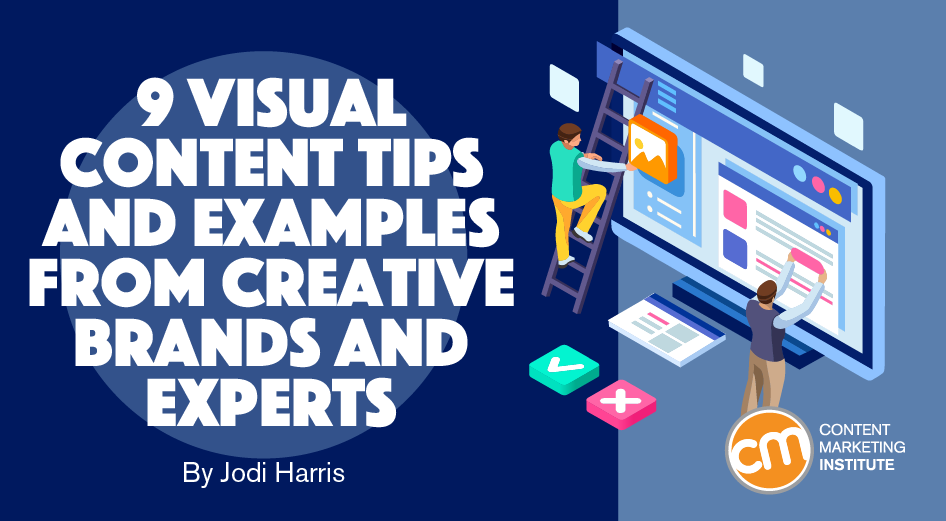
Updated March 30, 2022
Visuals are essential to creating content that will help your business stand out and draw in an audience. Not only does imagery help make text-centric content more eye-catching, digestible, and memorable, but it can communicate compelling messages that speak volumes without any text.
Visual trends and creative platforms come and go in the blink of a smartphone camera’s eye. Take a fresh look at how your brand’s photos, videos, and graphics can do the talking. This collection of best-practice tips comes from some of the industry’s most creative and design-minded content experts. It also includes best-in-show examples to inspire you to put your brand’s vision on display.
Take a fresh look at your brand’s photos, videos, and graphics to get a better focus on your #VisualContent strategy, says @joderama via @CMIContent @corpv. Click To Tweet
1. Consider the story – not just the visuals
Visual storytelling isn’t just about the pictures. Visuals should enable a clear, consistent story from your brand. Even if each individual visual asset doesn’t tell an obvious story, your audience should be able to follow the narrative thread.
It’s a point CMI’s chief strategy advisor Robert Rose emphasizes in his detailed Marketing Makers lesson on the subject. His top-line advice: Think like a storyteller. Then plan your visual media to represent and relate the story across all your platforms.
Think like a storyteller, then plan your visuals to tell the story across platforms, says @Robert_Rose via @joderama @CMIContent @corpv. Click To Tweet
It’s a lesson executed skillfully by the mindfulness app Calm. Whether viewing their ads in your Instagram Stories feed or scrolling the daily affirmations and meditations posted to its profile page, the cool blue color palette and serene background scenery create visual reinforcement of the brand’s overarching story of enabling people to find balance in their lives.

2. Align the visual story with your content marketing strategy
Posting a photo or video online and waiting for the business offers to start rolling in is not a strategy. Neither is hinging your visual content success on creating the next viral phenomenon. Like any content marketing format, you need a compelling rationale for visual storytelling and a clear plan for turning views into meaningful marketing results.
Posting a photo or video online and waiting for the business offers to start rolling in is not a strategy, says @joderama via @CMIContent @corpv. Click To Tweet
Before your creative team sketches any ideas, make sure they answer these questions:
- What are we trying to accomplish with our visual content?
- Who are our audience members? What kinds of content experiences interest them?
- What problems does our organization solve?
- What is our clearly defined vision of what makes our brand unique? How can we communicate those messages in a compelling and visually consistent way?
- What metrics will we use to measure success? For which terms should this image appear in search engine results?
To ensure your visual vision aligns with your marketing purpose, let audience preferences – not your gut feelings – guide the selection of themes, topics, and approaches.
For example, a current rule of thumb dictates videos should run between 30 seconds and six minutes. However, video pro Andrew Davis rarely creates videos less than seven minutes.
Don’t just follow best practices on #video length. Figure out what your audience responds best to, says @DrewDavisHere via @joderama @CMIContent @corpv. Click To Tweet
To find audience insights to guide your creative decision-making, Andrew suggests tracking:
- Audience retention rates: Compare the retention rates for each video. For example, one of his popular videos showed a 50% retention rate – half who viewed the video watched until the end. When videos fail to meet that retention rate, he does a deeper dive into their creative and technical details – length, topic, title, and tags – to discern what didn’t work well.
- Subscriber responses: Track direct replies to those who subscribe to your content. Andrew includes links to his videos in Loyalty Loop, a weekly email newsletter. “Lots of people click, open, and watch it, but the people who respond – especially when it’s about something that really hit a chord – help me understand what’s working because it tells me what they’re liking, what’s challenging them, and what are they learning,” he says.
- Comments: Read responses posted below the videos. Andrew mines the comments viewers leave on the YouTube page and below his LinkedIn posts where he shares the link.
TIP: If you’d like more guidance on building a strategic framework to support all your content efforts, this three-step content marketing strategy tutorial can help.
ADVERTISEMENT
Report: The Neuroscience of Digital Content
Your buyers are using digital content to discover, understand, and narrow their options before they make a buying decision. But, what makes content memorable?! Download the report.
3. Ensure images reflect and represent your whole audience
Images might speak a thousand words, but those words do not necessarily convey the same message to everyone – especially those who aren’t represented authentically in your brand’s visual stories.
African-American Marketing Association founder Michelle Ngome implores marketers to consider diversity in their content creation. “What kinds of content are you sharing on Instagram, Facebook, LinkedIn company pages, and Twitter? What do your messaging and images look like? Is there a healthy balance of perspectives shared in [your] choices of topics and the [faces and voices behind] your messages?… Does it prioritize the experiences of some groups over others?” Michelle asks.
A lot of organizations are diverse but are they inclusive, asks @MichelleNgome via @joderama @CMIContent @corpv. Click To Tweet
Michelle points to Rihanna’s lingerie brand Savage X Fenty as a shining example. She credits the brand’s broadly inclusive visualization model as a key reason it reached a $1 billion valuation just two years after launching. You can see evidence of that in a Valentine’s Day post shared on Instagram and Facebook emphasizing that sexy isn’t based on age, skin color, or sexual preference.
Keep in mind: Diversity doesn’t need to be the focal point of a visual story for it to play a key role. In fact, normalizing the representation of diverse communities as part and parcel of your creative process means you won’t have to think about it on an asset-by-asset basis. It will happen organically. That’s a goal GLAAD, Getty Images, and Ceros are working to further with their collaborative initiative Seeing is Believing.

A Getty Images’ Visual GPS 2021 Study found countries with greater representation of the LGBTQ+ community in their media and advertising exhibit less discrimination and less bias. The resulting partnership was forged to “elevate diverse narratives that can alter perceptions, evoke empathy, and build community.” The effort included a calendar of LGBTQ+ celebration days and a gated Visual Storytelling Guidebook to inspire increased inclusion and thoughtful portrayals of the LGBTQ+ community. Getty also compiled special collections of stock images emphasizing intersectionality and authenticity over the narrow, stereotypical depictions commonly seen in media.
4. Use your fans’ content – or let them do the work for you
Consumers love to snap pictures and share selfie videos with their friends. Instead of interrupting their experience with product shots and promotional pitches, why not include their creative work in your content marketing?
In a recent Teen Vogue article, Abercrombie & Fitch explains how it turned to the TikTok community for help shedding its early 2000s “preppy surfer” look. While the company ran sponsored ads and partner posts on the platform, much of the credit for its successful refresh is owed to the Gen Z consumers who posted their own videos tagged with #AbercrombieHaul and #AbercrombieStyle.
For example, Teen Vogue points to Andy Lobos’ TikTok video about Abercrombie’s logo-less hoodies, which earned over 1 million views. Once an Abercrombie product goes viral on TikTok, it typically sells out on the site.
@andy_lobosReply to @gunnawut surprisingly there is no logos on this just a good blank hoodie #fyp #abercrombie♬ original sound – led
5. Stay on brand
Whether fans are involved in your imagery or not, take steps to maintain your brand’s visual identity, including the use of corporate colors and logos. Ideally, all your content assets feature a consistent visual design – one that viewers instantly recognize no matter where the content appears or who creates it.
For example, Planters decided to sit out the 2021 Super Bowl ad frenzy in favor of a cause-based play to promote “little acts of extraordinary substance that make the world a better place.” But despite benching its ad, the brand didn’t bench its signature colors or its resurrected mascot in its videos and social media posts about the campaign:
For example, embedded links can be problematic if not used appropriately. Visual content strategy expert (and avowed comics geek) Buddy Scalera says a platform’s native tools might pick a less-preferred image from the content to display as the thumbnail or preview, or they might crop it in a way that robs some of its resonance and branding elements. As a workaround, he suggests using Open Graph tags – a piece of code that gives you greater control of the visual experience you’re trying to create.
Content marketers should wrest control of their visuals from @Microsoft, @Google, @Facebook, says @BuddyScalera via @joderama @CMIContent @corpv. Click To Tweet
TIP: Don’t forget to add your logo to original images and tag them with relevant keywords, categories, hashtags, and metadata. This helps your fans find your content even when shared in unfamiliar contexts.
6. Tailor visuals to the delivery platform
You also need to consider each sharing environment to determine how well the visuals fit the conversational context and audience preferences. Of course, with the right insights, your visuals can find an audience in places you wouldn’t expect to be a good fit.
For example, the Instagram audience might not seem like an obvious fit for the long-form literature at The New York Public Library. But its content team translated a series of text-heavy content into snackable visual segments that deserve a special place on its shelves of great works.
Insta Novels visualizes five iconic novels as Instagram Stories. Each edition includes the full text along with illustrations and an animated intro. It even includes a place to pause on every frame for those who aren’t skilled at reading in the platform’s 15-second increments. These visualized novels gained more than 300,000 views and added more than 140,000 followers to the library’s Instagram account.

[email protected] reinvented five classics novels – without changing a word – on #Instagram. They gained 140,000 followers, says @Everypixelcom via @CMIContent @corpv. Click To Tweet
HANDPICKED RELATED CONTENT:
7. Don’t be afraid to get emotional
Some of the most memorable visual experiences tap into the power of emotion. Need proof? I challenge you to watch this emotionally charged video from Oreo and not get a little misty-eyed at the display of fatherly love and acceptance:
This level of deliberate planning also helped the U.S. Humane Society catch the eyes of the 2021 Content Marketing Award judges, which recognized All Animals as a finalist in the Best Feature Design and Best Use of Photography categories and the winner for Best Nonprofit Publication.

Famed photographer Pete Souza captured plenty of posed snapshots while documenting the presidencies of Barack Obama and Ronald Reagan. Yet, in his keynote address at Content Marketing World 2021, Pete shared his most enduring images that say something essential about the person behind the institution.
He included many of those photographs in his two best-selling books, Obama: An Intimate Portrait and Shade: A Tale of Two Presidencies. “The way [Obama] interacted with other people showed what he was like as a human being,” Pete told the crowd.

8. Repurpose information and insights as visuals
A stock-image service can be a viable alternative when cutting-edge equipment (and the talent to operate it) is out of your price range. The key? Put your brand’s spin on the images before you publish them.
You also can “skin” your brand’s content without going the stock route, many of which might offer a stronger balance between cost-effectiveness and audience impact.
For example, in a content partnership with Quartz, Deloitte Global enlisted its creative services studio to help turn its lead-gen white paper on the millennial work experience into a highly immersive interactive version anchored by vibrant full-screen illustrations.
The cast of characters for The Resilient Generation was established with a drawing of an apartment and its inhabitants. Then, artist Paige Vickers created lush, individual scenes with whimsical details. She depicted three typical young professionals at home mid-pandemic — working next to a roommate, taking a mental health break with the dog, and preparing for a climate protest.

The original artwork might have been more expensive than stock art, but the investment paid off. A week after launch, Deloitte’s page visits grew approximately 964%, and white paper downloads increased 33%. It was also a hit with the 2021 Content Marketing Award judges, too, capturing the win for Best Use of Illustration.
9. Follow the patterns of effective design
A wealth of DIY design tools online and on social media gives almost anyone the ability to produce visual content. However, those tools still require some design chops to create clear, compelling, and readable images and videos.
That process can be simplified with design templates. That was the idea behind a holiday email campaign from Adobe Creative. It offered its newsletter subscribers intriguing ugly Christmas sweaters Photoshop templates. Customers could turn their favorite images into a virtual sweater pattern with just a few clicks.
Adobe’s newsletters also featured templates for cozy winter cards, as well as non-holiday options like how to make a risograph-style print in Photoshop.
Sharing visual content that helped Adobe’s audience create their own was a smart marketing play. It got creators to experiment with Photoshop’s tools and features while providing step-by-step instructions and delivering a free holiday gift of surprise and delight.
Audiences love free things – templates, tools, and images make great #content and great #email subscriber gifts. See examples from the @AdobeCreate newsletter via @joderama @CMIContent @corpv Click To Tweet
Of course, when working with templates isn’t a viable option, your best bet is to default to the basic principles of good design. Here are a few to keep in mind:
- Give your imagery room to breathe: Failing to leave enough white space between visuals can make a page cluttered and hard to follow. Remove images that don’t add to the visual conversation and expand the space between unrelated elements to clarify page structure.
- Don’t get color-blindsided: Stay true to your branding guidelines, including color preferences. But don’t get so caught up in executing this priority that you overlook whether those colors will work well together online. Pick one color to use as a base, then find complementary colors with an online color-wheel tool.
- Speed up your page loads: Visual experiences are slowed when images aren’t properly sized and compressed. Use tools (like this simple one from Google) to check how quickly images load. If it’s too long, adjust for consumption on different platforms and devices, including mobile.
- Make good typography decisions: Not only is choosing the proper font size, weight, and spacing critical to readability, but poor typography decisions can conflict with crafting understandable and memorable messages.
TIP: Don’t forget to get your visuals shared as far and wide as all your other assets. Influencers can be instrumental to this goal, especially on social media. Make it easy for them by offering multiple options – such as tagging them on social media or providing direct access to the raw files for download.
How do you visualize your brand’s story?
Of course, these ideas are just the tip of the iceberg. You’ll find more image-centric inspiration in CMI’s content hub on the subject. We also would love to hear how other businesses are painting pictures of marketing success. Tell us about your favorites in the comments.
All tools mentioned in the article are identified by the author. If you have a tool to suggest, please feel free to add it in the comments.
Cover image by Joseph Kalinowski/Content Marketing Institute
MARKETING
How to create editorial guidelines that are useful + template

Before diving in to all things editorial guidelines, a quick introduction. I head up the content team here at Optimizely. I’m responsible for developing our content strategy and ensuring this aligns to our key business goals.
Here I’ll take you through the process we used to create new editorial guidelines; things that worked well and tackle some of the challenges that come with any good multi – stakeholder project, share some examples and leave you with a template you can use to set your own content standards.
What are editorial guidelines?
Editorial guidelines are a set of standards for any/all content contributors, etc. etc. This most often includes guidance on brand, tone of voice, grammar and style, your core content principles and the types of content you want to produce.
Editorial guidelines are a core component of any good content strategy and can help marketers achieve the following in their content creation process:
- Consistency: All content produced, regardless of who is creating it, maintains a consistent tone of voice and style, helping strengthen brand image and making it easier for your audience to recognize your company’s content
- Quality Control: Serves as a ‘North Star’ for content quality, drawing a line in the sand to communicate the standard of content we want to produce
- Boosts SEO efforts: Ensures content creation aligns with SEO efforts, improving company visibility and increasing traffic
- Efficiency: With clear guidelines in place, content creators – external and internal – can work more efficiently as they have a clear understanding of what is expected of them
Examples of editorial guidelines
There are some great examples of editorial guidelines out there to help you get started.
Here are a few I used:
1. Editorial Values and Standards, the BBC
Ah, the Beeb. This really helped me channel my inner journalist and learn from the folks that built the foundation for free quality journalism.
How to create editorial guidelines, Pepperland Marketing
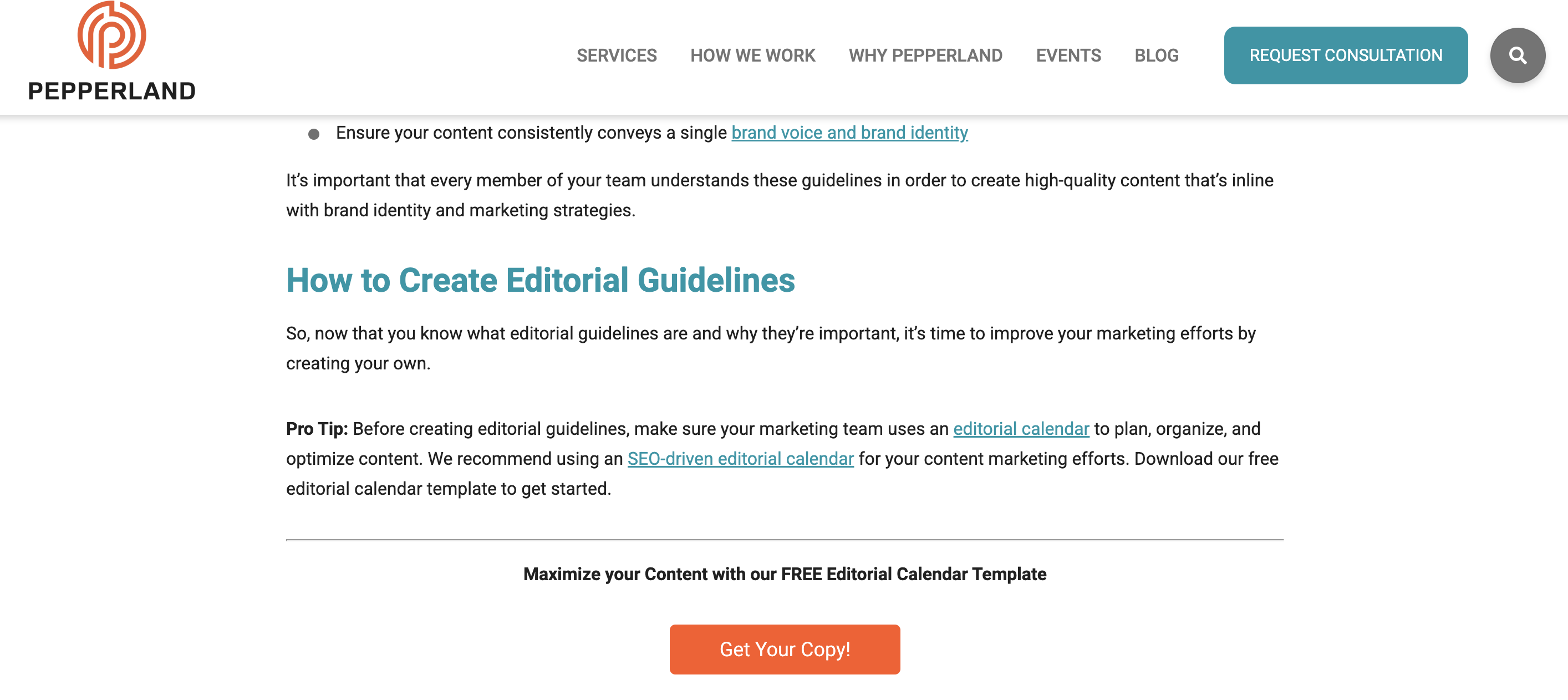
After taking a more big picture view I recognized needed more focused guidance on the step by step of creating editorial guidelines.
I really liked the content the good folks at Pepperland Marketing have created, including a free template – thanks guys! – and in part what inspired me to create our own free template as a way of sharing learnings and helping others quickstart the process of creating their own guidelines.
3. Writing guidelines for the role of AI in your newsroom?… Nieman Lab
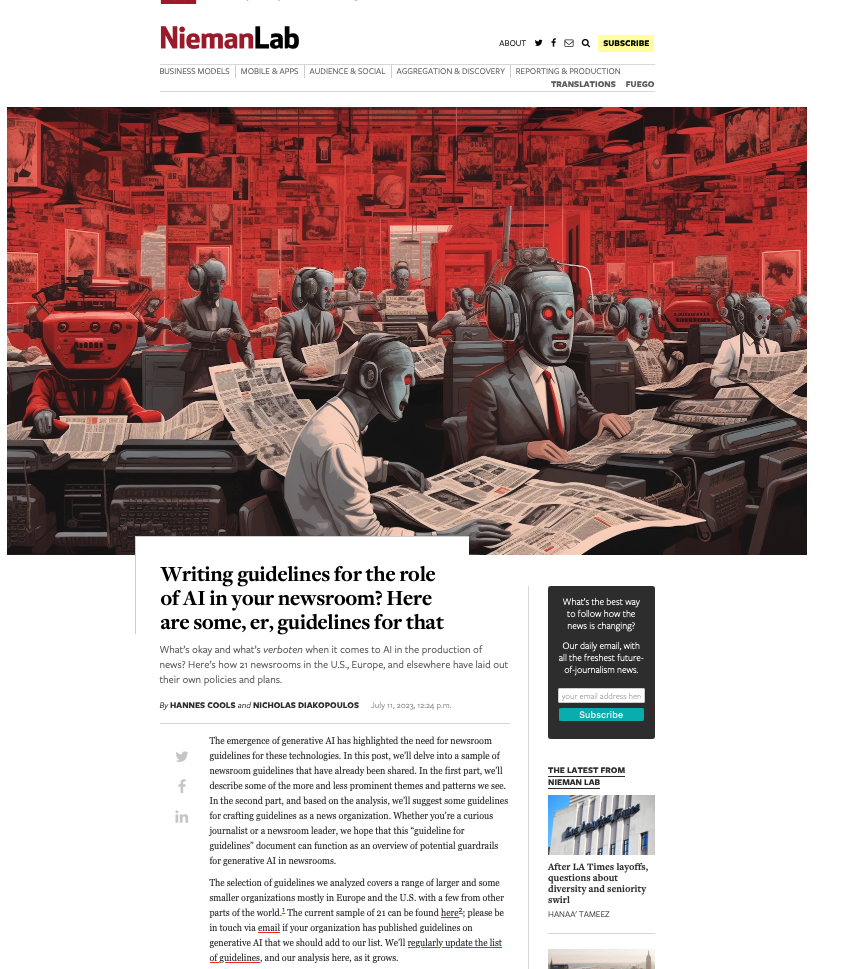
As well as provide guidance on content quality and the content creation process, I wanted to tackle the thorny topic of AI in our editorial guidelines. Specifically, to give content creators a steer on ‘fair’ use of AI when creating content, to ensure creators get to benefit from the amazing power of these tools, but also that content is not created 100% by AI and help them understand why we feel that contravenes our core content principles of content quality.
So, to learn more I devoured this fascinating article, sourcing guidance from major media outlets around the world. I know things change very quickly when it comes to AI, but I highly encourage reading this and taking inspiration from how these media outlets are tackling this topic.
Learn more: The Marketer’s Guide to AI-generated content
Why did we decide to create editorial guidelines?
1. Aligning content creators to a clear vision and process
Optimizely as a business has undergone a huge transformation over the last 3 years, going through rapid acquisition and all the joys and frustrations that can bring. As a content team, we quickly recognized the need to create a set of clear and engaging guidelines that helps content creators understand how and where they can contribute, and gave a clear process to follow when submitting a content idea for consideration.
2. Reinvigorated approach to brand and content
As a brand Optimizely is also going through a brand evolution – moving from a more formal, considered tone of voice to one that’s much more approachable, down to earth and not afraid to use humor, different in content and execution.
See, our latest CMS campaign creative:
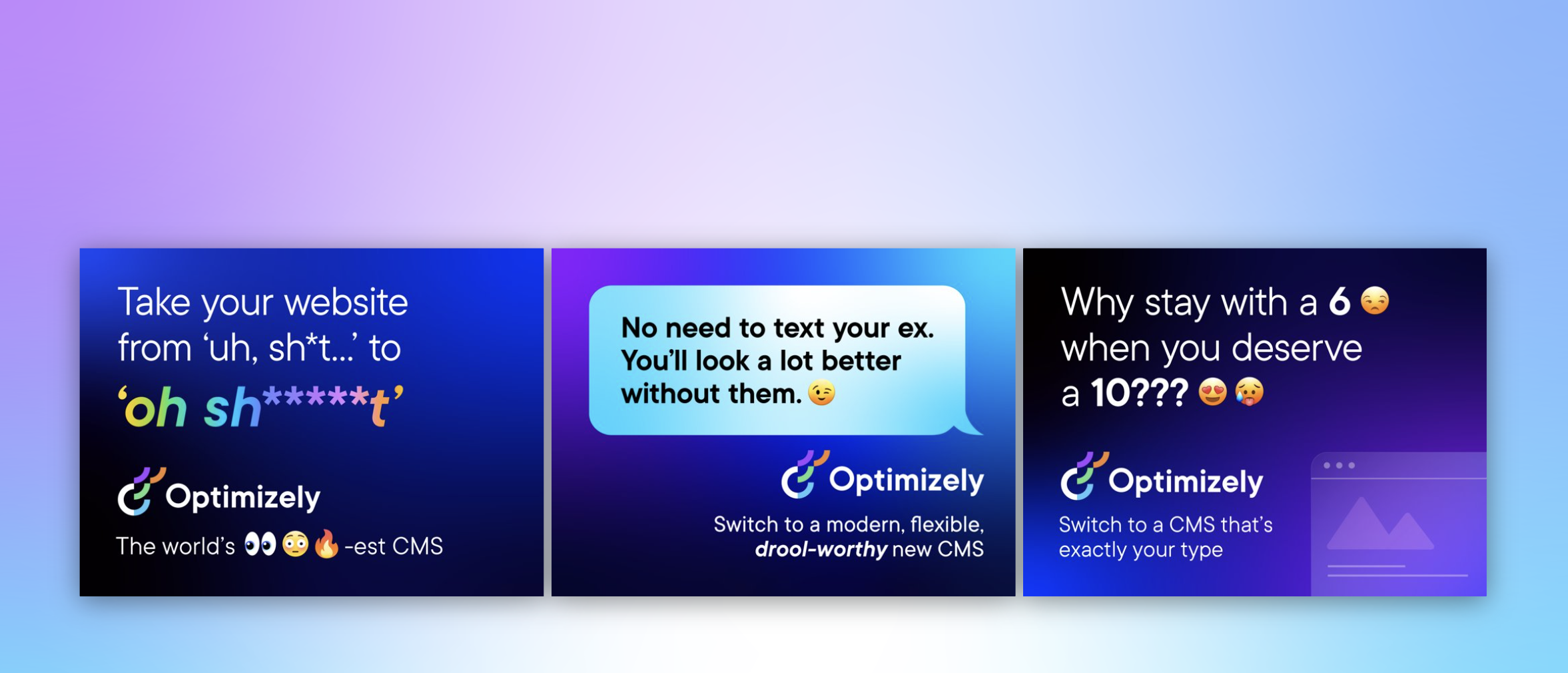
It’s pretty out there in terms of creative and messaging. It’s an ad campaign that’s designed to capture attention yes, but also – to demonstrate our abilities as a marketing team to create this type of campaign that is normally reserved for other more quote unquote creative industries.
We wanted to give guidance to fellow content creators outside the team on how they can also create content that embraces this evolved tone of voice, while at the same time ensuring content adheres to our brand guidelines.
3. Streamline content creation process
Like many global enterprises we have many different content creators, working across different time zones and locations. Documenting a set of guidelines and making them easily available helps content creators quickly understand our content goals, the types of content we want to create and why. It would free up content team time spent with individual contributors reviewing and editing submissions, and would ensure creation and optimization aligns to broader content & business goals.
It was also clear that we needed to document a process for submitting content ideas, so we made sure to include this in the guidelines themselves to make it easy and accessible for all contributors.
4. 2023 retrospective priority
As a content team we regularly review our content strategy and processes to ensure we’re operating as efficiently as possible.
In our last retrospective. I asked my team ‘what was the one thing I could do as a manager to help them be more impactful in their role?’
Editorial guidelines was the number 1 item on their list.
So off we went…
What we did
- Defined a discrete scope of work for the first version of the editorial guidelines, focusing on the Blog and Resources section of the website. This is where the content team spends most of its time and so has most involvement in the content creation process. Also where the most challenging bottlenecks have been in the past
- Research. Reviewed what was out there, got my hands on a few free templates and assembled a framework to create a first version for inputs and feedback
- Asked content community – I put a few questions out to my network on LinkedIn on the topic of content guidelines and content strategy, seeking to get input and guidance from smart marketers.
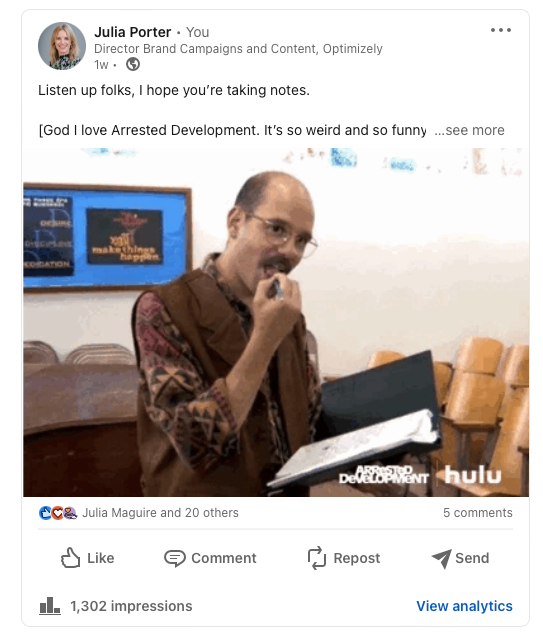
- Invited feedback: Over the course of a few weekswe invited collaborators to comment in a shared doc as a way of taking iterative feedback, getting ideas for the next scope of work, and also – bringing people on the journey of creating the guidelines. Look at all those reviewers! Doing this within our Content Marketing Platform (CMP) ensured that all that feedback was captured in one place, and that we could manage the process clearly, step by step:
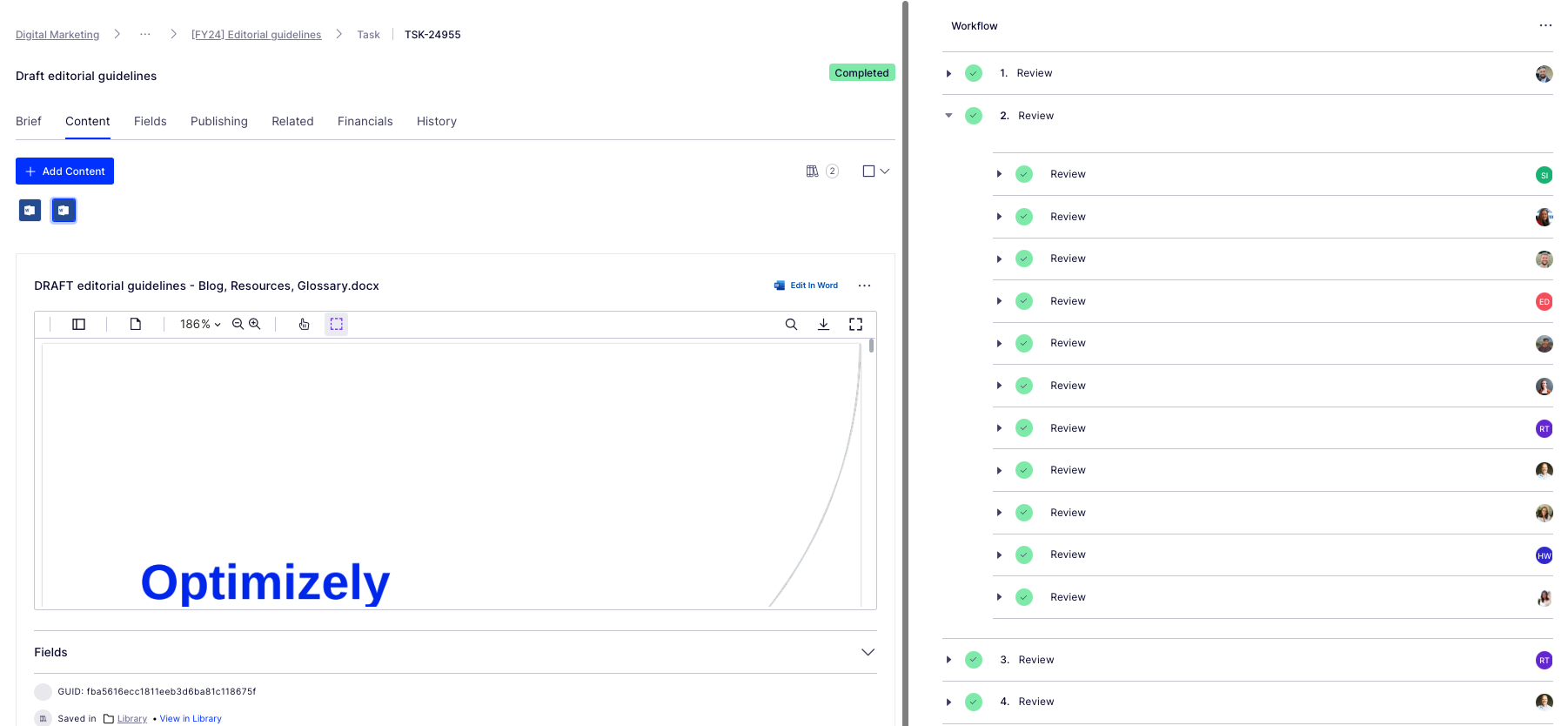
Look at all those collaborators! Thanks guys! And all of those beautiful ticks, so satisfying. So glad I could crop out the total outstanding tasks for this screen grab too (Source – Optimizely CMP)
- Updated content workflow: Now we have clear, documented guidance in place, we’ve included this as a step – the first step – in the workflow used for blog post creation:
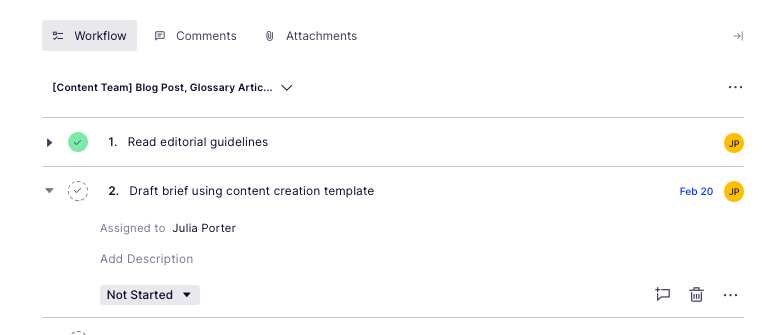
Source: Optimizely CMP
Results
It’s early days but we’re already seeing more engagement with the content creation process, especially amongst the teams involved in building the guidelines (which was part of the rationale in the first place :))

Source: My Teams chat
It’s inspired teams to think differently about the types of content we want to produce going forwards – for the blog and beyond.
I’d also say it’s boosted team morale and collaboration, helping different teams work together on shared goals to produce better quality work.
What’s next?
We’re busy planning wider communication of the editorial guidelines beyond marketing. We’ve kept the original draft and regularly share this with existing and potential collaborators for ongoing commentary, ideas and feedback.
Creating guidelines has also sparked discussion about the types of briefs and templates we want and need to create in CMP to support creating different assets. Finding the right balance between creative approach and using templates to scale content production is key.
We’ll review these guidelines on a quarterly basis and evolve as needed, adding new formats and channels as we go.
Key takeaways
- Editorial guidelines are a useful way to guide content creators as part of your overall content strategy
- Taking the time to do research upfront can help accelerate seemingly complex projects. Don’t be afraid to ask your community for inputs and advice as you create
- Keep the scope small at first rather than trying to align everything all at once. Test and learn as you go
- Work with stakeholders to build guidelines from the ground up to ensure you create a framework that is useful, relevant and used
And lastly, here’s that free template we created to help you build or evolve your own editorial guidelines!
MARKETING
Effective Communication in Business as a Crisis Management Strategy

Everyday business life is full of challenges. These include data breaches, product recalls, market downturns and public relations conflicts that can erupt at any moment. Such situations pose a significant threat to a company’s financial health, brand image, or even its further existence. However, only 49% of businesses in the US have a crisis communications plan. It is a big mistake, as such a strategy can build trust, minimize damage, and even strengthen the company after it survives the crisis. Let’s discover how communication can transform your crisis and weather the chaos.
The ruining impact of the crisis on business
A crisis can ruin a company. Naturally, it brings losses. But the actual consequences are far worse than lost profits. It is about people behind the business – they feel the weight of uncertainty and fear. Employees start worrying about their jobs, customers might lose faith in the brand they once trusted, and investors could start looking elsewhere. It can affect the brand image and everything you build from the branding, business logo, social media can be ruined. Even after the crisis recovery, the company’s reputation can suffer, and costly efforts might be needed to rebuild trust and regain momentum. So, any sign of a coming crisis should be immediately addressed. Communication is one of the crisis management strategies that can exacerbate the situation.
The power of effective communication
Even a short-term crisis may have irreversible consequences – a damaged reputation, high employee turnover, and loss of investors. Communication becomes a tool that can efficiently navigate many crisis-caused challenges:
- Improved trust. Crisis is a synonym for uncertainty. Leaders may communicate trust within the company when the situation gets out of control. Employees feel valued when they get clear responses. The same applies to the customers – they also appreciate transparency and are more likely to continue cooperation when they understand what’s happening. In these times, documenting these moments through event photographers can visually reinforce the company’s messages and enhance trust by showing real, transparent actions.
- Reputation protection. Crises immediately spiral into gossip and PR nightmares. However, effective communication allows you to proactively address concerns and disseminate true information through the right channels. It minimizes speculation and negative media coverage.
- Saved business relationships. A crisis can cause unbelievable damage to relationships with employees, customers, and investors. Transparent communication shows the company’s efforts to find solutions and keeps stakeholders informed and engaged, preventing misunderstandings and painful outcomes.
- Faster recovery. With the help of communication, the company is more likely to receive support and cooperation. This collaborative approach allows you to focus on solutions and resume normal operations as quickly as possible.
It is impossible to predict when a crisis will come. So, a crisis management strategy mitigates potential problems long before they arise.
Tips on crafting an effective crisis communication plan.
To effectively deal with unforeseen critical situations in business, you must have a clear-cut communication action plan. This involves things like messages, FAQs, media posts, and awareness of everyone in the company. This approach saves precious time when the crisis actually hits. It allows you to focus on solving the problem instead of intensifying uncertainty and panic. Here is a step-by-step guide.
Identify your crisis scenarios.
Being caught off guard is the worst thing. So, do not let it happen. Conduct a risk assessment to pinpoint potential crises specific to your business niche. Consider both internal and external factors that could disrupt normal operations or damage the online reputation of your company. Study industry-specific issues, past incidents, and current trends. How will you communicate in each situation? Knowing your risks helps you prepare targeted communication strategies in advance. Of course, it is impossible to create a perfectly polished strategy, but at least you will build a strong foundation for it.
Form a crisis response team.
The next step is assembling a core team. It will manage communication during a crisis and should include top executives like the CEO, CFO, and CMO, and representatives from key departments like public relations and marketing. Select a confident spokesperson who will be the face of your company during the crisis. Define roles and responsibilities for each team member and establish communication channels they will work with, such as email, telephone, and live chat. Remember, everyone in your crisis response team must be media-savvy and know how to deliver difficult messages to the stakeholders.
Prepare communication templates.
When a crisis hits, things happen fast. That means communication needs to be quick, too. That’s why it is wise to have ready-to-go messages prepared for different types of crises your company may face. These messages can be adjusted to a particular situation when needed and shared on the company’s social media, website, and other platforms right away. These templates should include frequently asked questions and outline the company’s general responses. Make sure to approve these messages with your legal team for accuracy and compliance.
Establish communication protocols.
A crisis is always chaotic, so clear communication protocols are a must-have. Define trigger points – specific events that would launch the crisis communication plan. Establish a clear hierarchy for messages to avoid conflicting information. Determine the most suitable forms and channels, like press releases or social media, to reach different audiences. Here is an example of how you can structure a communication protocol:
- Immediate alert. A company crisis response team is notified about a problem.
- Internal briefing. The crisis team discusses the situation and decides on the next steps.
- External communication. A spokesperson reaches the media, customers, and suppliers.
- Social media updates. A trained social media team outlines the situation to the company audience and monitors these channels for misinformation or negative comments.
- Stakeholder notification. The crisis team reaches out to customers and partners to inform them of the incident and its risks. They also provide details on the company’s response efforts and measures.
- Ongoing updates. Regular updates guarantee transparency and trust and let stakeholders see the crisis development and its recovery.
Practice and improve.
Do not wait for the real crisis to test your plan. Conduct regular crisis communication drills to allow your team to use theoretical protocols in practice. Simulate different crisis scenarios and see how your people respond to these. It will immediately demonstrate the strong and weak points of your strategy. Remember, your crisis communication plan is not a static document. New technologies and evolving media platforms necessitate regular adjustments. So, you must continuously review and update it to reflect changes in your business and industry.
Wrapping up
The ability to handle communication well during tough times gives companies a chance to really connect with the people who matter most—stakeholders. And that connection is a foundation for long-term success. Trust is key, and it grows when companies speak honestly, openly, and clearly. When customers and investors trust the company, they are more likely to stay with it and even support it. So, when a crisis hits, smart communication not only helps overcome it but also allows you to do it with minimal losses to your reputation and profits.
MARKETING
Should Your Brand Shout Its AI and Marketing Plan to the World?

To use AI or not to use AI, that is the question.
Let’s hope things work out better for you than they did for Shakespeare’s mad Danish prince with daddy issues.
But let’s add a twist to that existential question.
CMI’s chief strategy officer, Robert Rose, shares what marketers should really contemplate. Watch the video or read on to discover what he says:
Should you not use AI and be proud of not using it? Dove Beauty did that last week.
Should you use it but keep it a secret? Sports Illustrated did that last year.
Should you use AI and be vocal about using it? Agency giant Brandtech Group picked up the all-in vibe.
Should you not use it but tell everybody you are? The new term “AI washing” is hitting everywhere.
What’s the best option? Let’s explore.
Dove tells all it won’t use AI
Last week, Dove, the beauty brand celebrating 20 years of its Campaign for Real Beauty, pledged it would NEVER use AI in visual communication to portray real people.
In the announcement, they said they will create “Real Beauty Prompt Guidelines” that people can use to create images representing all types of physical beauty through popular generative AI programs. The prompt they picked for the launch video? “The most beautiful woman in the world, according to Dove.”
I applaud them for the powerful ad. But I’m perplexed by Dove issuing a statement saying it won’t use AI for images of real beauty and then sharing a branded prompt for doing exactly that. Isn’t it like me saying, “Don’t think of a parrot eating pizza. Don’t think about a parrot eating pizza,” and you can’t help but think about a parrot eating pizza right now?
Brandtech Group says it’s all in on AI
Now, Brandtech Group, a conglomerate ad agency, is going the other way. It’s going all-in on AI and telling everybody.
This week, Ad Age featured a press release — oops, I mean an article (subscription required) — with the details of how Brandtech is leaning into the takeaway from OpenAI’s Sam Altman, who says 95% of marketing work today can be done by AI.
A Brandtech representative talked about how they pitch big brands with two people instead of 20. They boast about how proud they are that its lean 7,000 staffers compete with 100,000-person teams. (To be clear, showing up to a pitch with 20 people has never been a good thing, but I digress.)
OK, that’s a differentiated approach. They’re all in. Ad Age certainly seemed to like it enough to promote it. Oops, I mean report about it.
False claims of using AI and not using AI
Offshoots of the all-in and never-will approaches also exist.
The term “AI washing” is de rigueur to describe companies claiming to use AI for something that really isn’t AI. The US Securities and Exchange Commission just fined two companies for using misleading statements about their use of AI in their business model. I know one startup technology organization faced so much pressure from their board and investors to “do something with AI” that they put a simple chatbot on their website — a glorified search engine — while they figured out what they wanted to do.
Lastly and perhaps most interestingly, companies have and will use AI for much of what they create but remain quiet about it or desire to keep it a secret. A recent notable example is the deepfake ad of a woman in a car professing the need for people to use a particular body wipe to get rid of body odor. It was purported to be real, but sharp-eyed viewers suspected the fake and called out the company, which then admitted it. Or was that the brand’s intent all along — the AI-use outrage would bring more attention?
This is an AI generated influencer video.
Looks 100% real. Even the interior car detailing.
UGC content for your brand is about to get really cheap. ☠️ pic.twitter.com/2m10RqoOW3
— Jon Elder | Amazon Growth | Private Label (@BlackLabelAdvsr) March 26, 2024
To yell or not to yell about your brand’s AI decision
Should a brand yell from a mountaintop that they use AI to differentiate themselves a la Brandtech? Or should a brand yell they’re never going to use AI to differentiate themselves a la Dove? Or should a brand use it and not yell anything? (I think it’s clear that a brand should not use AI and lie and say it is. That’s the worst of all choices.)
I lean far into not-yelling-from-mountaintop camp.
When I see a CEO proudly exclaim that they laid off 90% of their support workforce because of AI, I’m not surprised a little later when the value of their service is reduced, and the business is failing.
I’m not surprised when I hear “AI made us do it” to rationalize the latest big tech company latest rounds of layoffs. Or when a big consulting firm announces it’s going all-in on using AI to replace its creative and strategic resources.
I see all those things as desperate attempts for short-term attention or a distraction from the real challenge. They may get responses like, “Of course, you had to lay all those people off; AI is so disruptive,” or “Amazing. You’re so out in front of the rest of the pack by leveraging AI to create efficiency, let me cover your story.” Perhaps they get this response, “Your company deserves a bump in stock price because you’re already using this fancy new technology.”
But what happens if the AI doesn’t deliver as promoted? What happens the next time you need to lay off people? What happens the next time you need to prove your technologically forward-leaning?
Yelling out that you’re all in on a disruptive innovation, especially one the public doesn’t yet trust a lot is (at best) a business sugar high. That short-term burst of attention may or may not foul your long-term brand value.
Interestingly, the same scenarios can manifest when your brand proclaims loudly it is all out of AI, as Dove did. The sugar high may not last and now Dove has itself into a messaging box. One slip could cause distrust among its customers. And what if AI gets good at demonstrating diversity in beauty?
I tried Dove’s instructions and prompted ChatGPT for a picture of “the most beautiful woman in the world according to the Dove Real Beauty ad.”
It gave me this. Then this. And this. And finally, this.
She’s absolutely beautiful, but she doesn’t capture the many facets of diversity Dove has demonstrated in its Real Beauty campaigns. To be clear, Dove doesn’t have any control over generating the image. Maybe the prompt worked well for Dove, but it didn’t for me. Neither Dove nor you can know how the AI tool will behave.
To use AI or not to use AI?
When brands grab a microphone to answer that question, they work from an existential fear about the disruption’s meaning. They do not exhibit the confidence in their actions to deal with it.
Let’s return to Hamlet’s soliloquy:
Thus conscience doth make cowards of us all;
And thus the native hue of resolution
Is sicklied o’er with the pale cast of thought,
And enterprises of great pith and moment
With this regard their currents turn awry
And lose the name of action.
In other words, Hamlet says everybody is afraid to take real action because they fear the unknown outcome. You could act to mitigate or solve some challenges, but you don’t because you don’t trust yourself.
If I’m a brand marketer for any business (and I am), I’m going to take action on AI for my business. But until I see how I’m going to generate value with AI, I’m going to be circumspect about yelling or proselytizing how my business’ future is better.
HANDPICKED RELATED CONTENT:
Cover image by Joseph Kalinowski/Content Marketing Institute
-
SEARCHENGINES6 days ago
Daily Search Forum Recap: April 19, 2024
-

 WORDPRESS6 days ago
WORDPRESS6 days ago13 Best HubSpot Alternatives for 2024 (Free + Paid)
-

 WORDPRESS6 days ago
WORDPRESS6 days ago7 Best WooCommerce Points and Rewards Plugins (Free & Paid)
-

 MARKETING6 days ago
MARKETING6 days agoBattling for Attention in the 2024 Election Year Media Frenzy
-

 MARKETING5 days ago
MARKETING5 days agoAdvertising in local markets: A playbook for success
-

 SEO6 days ago
SEO6 days agoGoogle Answers Whether Having Two Sites Affects Rankings
-

 SEARCHENGINES5 days ago
SEARCHENGINES5 days agoGoogle Core Update Flux, AdSense Ad Intent, California Link Tax & More
-

 AFFILIATE MARKETING6 days ago
AFFILIATE MARKETING6 days agoGrab Microsoft Project Professional 2021 for $20 During This Flash Sale


















You must be logged in to post a comment Login